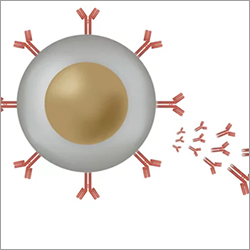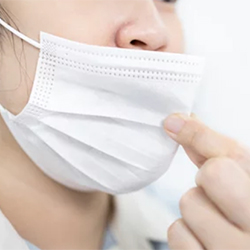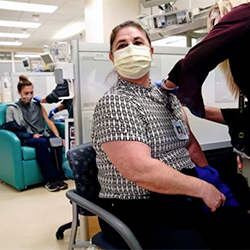By Marie Rosenthal
Learning to Fly: COVID-19 Variants Getting Better at Airborne Transmission
A new study found that SARS-CoV-2 is evolving toward more efficient aerosol generation, and loose-fitting masks provide only modest source control (Clin Infect Dis 2021 Sep 14. https://doi.org/10.1093/cid/ciab797).
Until vaccination rates are very high, continued layered controls—including improved ventilation, increased filtration, UV air sanitation and tight-fitting masks—are critical to protect people in public-facing jobs and indoor spaces, the researchers urged.
Led by the University of Maryland (UMD) School of Public Health, the study showed that people infected with the virus exhale infectious aerosols in their breath. And those infected with the alpha variant, the dominant strain circulating at the time this study was conducted, put 43 to 100 times more virus into the air than people infected with the original strains of the virus.
The researchers also found that tight-fitting cloth and surgical masks reduced the amount of virus that gets into the air around infected people by about half.
The amount of virus in the air coming from alpha variant infections was 18 times more than could be ex-plained by the increased amounts of virus in nasal swabs and saliva. One of the lead authors, doctoral student Jianyu Lai, explained that “we already knew that virus in saliva and nasal swabs was increased in alpha variant infections. Virus from the nose and mouth might be transmitted by sprays of large droplets up close to an infected person. But, our study shows that the virus in exhaled aerosols is increasing even more.”
These major increases in airborne virus from alpha infections occurred before the delta variant arrived and indicate that the virus is evolving to be better at traveling through the air.
To test whether face masks effectively block the virus from being transmitted among people, this study measured how much SARS-CoV-2 is breathed into the air and tested how much less virus people sick with COVID-19 exhaled into the air after wearing a cloth or surgical mask. Face coverings significantly reduced virus-laden particles in the air around the person with COVID-19, cutting the amount by about 50%. Unfortunately, the loose-fitting cloth and surgical masks didn’t prevent infectious virus from escaping into the air.
“The take-home messages from this paper are that the coronavirus can be in your exhaled breath, is getting better at being in your exhaled breath, and using a mask reduces the chance of you breathing it on others,” said Jennifer German, MD, a clinical professor at UMD, so a layering approach, including masks and vaccination, is needed.
More Memory B Cells Exist in Fully Vaccinated People With Previous SARS-CoV-2 Infection
A new study shows differences in immune responses among those vaccinated, including the amount of memory B cells and their vaccine-binding performance.

Some people who received a messenger RNA (mRNA) vaccination for COVID-19 have greater immune responses compared with others. While the vaccine induces strong immune responses against the virus in almost everyone, data show those who were previously infected with the virus have even greater immune responses after vaccination compared with fully vaccinated people who never had COVID-19 (Cell Rep 2021 Sep 25. doi:10.1016/j.celrep.2021.109823). The researchers sequenced more than 300,000 samples.
“Memory B cells are capable of rapid antibody production after reinfection, which is critical for immunity as antibody levels decline,” said Marc Jenkins, PhD, a professor and the director of the Center for Immunology at the University of Minnesota Medical School, in Minneapolis.
The study found that:
- people with a previous SARS-CoV-2 infection had a large number of spike-specific memory B cells before vaccination, and after the first dose of an mRNA vaccine, had a significant boost in spike-specific memory B cells—but not after the second dose;
- despite the weaker response to the second mRNA dose, people with a previous SARS-CoV-2 infec-tion still ended up with a larger number of spike-specific memory B cells than fully vaccinated people who never had the virus; and
- the spike-specific memory B cells in people with a previous SARS-CoV-2 infection bound more tightly to the spike protein of the virus compared with the memory B cells induced in uninfected people after a single mRNA vaccination.
“Our results show the benefit that people who had a SARS-CoV-2 infection get from vaccination and predict that this group may have fewer breakthrough infections,” Dr. Jenkins said. “While it’s unclear how many memory B cells are needed for protection against infection, our data also indicates that people who had a previous infection and were then fully vaccinated are the least likely group to need a third—or booster—shot.”
Why Are There Breakthrough Infections?
Using bioinformatics tools and programming, the team from the University of Missouri-Columbia (MU) College of Veterinary Medicine and the University of Nebraska Medical Center identified five specific mutations that are far more prevalent in delta plus infections compared with delta infections, including one mutation, K417N, that is present in all delta plus infections but not present in nearly any delta infections. The findings provide important clues to researchers about the recent structural changes to the virus and highlight the need to expand the toolbox in the fight against COVID-19 (J Autoimmun 2021;124:102715).
“Whether it is natural antibodies produced from previously having COVID-19 or the antibodies produced from the vaccine, we are showing structurally how dangerous and clever the virus is by being able to mutate in a way that the antibodies don’t seem to recognize and defend against these new variants,” explained Aus-tin Spratt, an undergraduate student at MU and a co-author of the study. “These findings help explain why there have been so many people testing positive for the delta variants despite being vaccinated or having previously been infected with COVID-19.”
Kamlendra Singh, PhD, a professor at MU, explained that while COVID-19 vaccines have been effective, another possible tool in responding to the pandemic could be the development of antiviral drugs that target specific areas of the virus that remain unchanged by mutations.
“There has not yet been a vaccine for HIV due to the unpredictable variability that often comes with viruses that mutate frequently,” Dr. Singh said. “If we can develop small-molecule drugs that target the part of the virus that does not mutate, that will be the ultimate solution for combating the virus.”
“Evolutionary Analysis of the Delta and Delta Plus Variants of the SARS-CoV-2 Viruses” was recently published in the Journal of Autoimmunity. Funding was provided by MU’s Bond Life Sciences Center and the National Strategic Research Institute at the University of Nebraska.
With Time and Without Masks, COVID-19 Vaccines Wane in Protection
A study of highly vaccinated health care workers (HCWs) found that the more contagious delta variant, combined with the end of the masking mandate, was associated with increased breakthrough cases, paralleling an exponential rise of COVID-19 infections in the San Diego community (N Engl J Med 2021;385:1330-1332).

An interdisciplinary team of physicians and public health experts at the University of California, San Diego measured the effectiveness of COVID-19 mRNA vaccines among HCWs at UC San Diego Health, most notably during the emergence of the highly transmissible delta virus variant and coincident with the end of the state’s mask mandate, allowing fully vaccinated persons to forgo face coverings in most places.
The letter’s authors reported that the effectiveness of both the Pfizer-BioNTech and Moderna mRNA COVID-19 vaccines significantly waned over time. Both vaccines were granted emergency use authorization in December 2020, with vaccinations of the UC San Diego Health workforce beginning the same month for HCWs with direct, patient-facing duties.
They noted that from March through June 2021, vaccine effectiveness against symptomatic infection was estimated to exceed 90%; by July, however, it had fallen to approximately 65%.
“Clinical trial data suggested decreased effectiveness would occur several months after full vaccination, but our findings indicate that confronted by the delta variant, vaccine effectiveness for mildly symptomatic disease was considerably lower and waned six to eight months after completing vaccination,” said co-senior author Francesca Torriani, MD, a professor of clinical medicine in the Division of Infectious Diseases and Global Public Health at the UC San Diego School of Medicine, and the program director of Infection Prevention and Clinical Epidemiology at UC San Diego Health.
UC San Diego Health, with a workforce of approximately 19,000, operates a robust SARS-CoV-2 testing program. If an employee reports even one mild symptom of COVID-19 during daily screening or an identified exposure, a test is triggered.
Then and now, UC San Diego Health has maintained rigorous, mandatory masking and transmission mitigation measures throughout its hospitals and clinical facilities. Diagnosed positive cases among HCWs have universally been identified as community acquired.
In December 2020, workers at UC San Diego Health, like the population overall, began experiencing a surge of SARS-CoV-2 infections.
The situation improved significantly after UC San Diego Health began to inoculate employees using the Pfizer-BioNTech and Moderna vaccines. By March 2021, 76% of workers were fully vaccinated, rising to 83% by July 2021.
Concomitant with increased vaccination coverage was a decline between March and June in the number of workers reporting at least one symptom of COVID-19 and a positive polymerase chain reaction test.
In July 2021, however, cases among this highly vaccinated population began to rise again, coincident with the emerging dominance of the delta variant in San Diego and the ending of California’s mask mandate on June 15. By July, 125 workers had been diagnosed with SARS-CoV-2, and unlike in previous months when approximately 20% of these cases involved vaccinated workers, the percentage had risen to 75%.
Of note, the vaccines still provide significant protection from severe infection outcomes, such as hospitalization and death. Among the UC San Diego Health employee cases documented, no hospitalizations were re-ported in vaccinated individuals and only one among unvaccinated HCWs.
“Unlike what was experienced with other variants, with the delta variant parents are frequently getting infected by their young children, ages 5 to 11,” said co-first author Lucy Horton, MD, MPH, an assistant professor of medicine in the Division of Infectious Diseases and the director of the UC San Diego Health COVID-19 case investigation and contact tracing team. “Unvaccinated people are seven times more likely to test positive for COVID-19 than those who are fully vaccinated. More importantly, while children rarely need medical attention, unvaccinated adults are 32 times more likely to require hospitalization compared with those who are fully vaccinated.”
The vaccines waned over time. For workers diagnosed in July, those who became fully vaccinated in Janu-ary and February had higher infection rates than those vaccinated later in March through May. The infection rate among unvaccinated persons has remained consistently higher than for any vaccinated group, although the difference in rates between the two groups has decreased over time.
Second Vaccine Dose Needed for Those Infected With COVID-19 Shortly After First Dose
A second dose of the COVID-19 vaccine should be offered to individuals infected with the virus shortly after receiving the first dose, according to findings recently published by the Azrieli Faculty of Medicine of Bar-Ilan University and Ziv Medical Center, in Israel (Epidemiol Infect 2021 Aug 21. doi:10.1017/S0950268821001928).

The epidemiologists tracked a cohort of 541 Ziv Medical Center HCWs—some of whom had already recovered from COVID-19—to determine how those previously infected with COVID-19 responded to vaccination compared with those who weren’t infected.
In this joint study, HCWs at Ziv Medical Center, one of the main hospitals in northern Israel, regularly provided blood samples to measure their antibody levels following vaccination. A number of differences emerged after sample analysis of individuals infected pre- and post-vaccination, and those who were never infected.
Previously infected individuals who received one dose of the vaccine had much higher immunoglobulin G (IgG) antibody levels than fully vaccinated workers who were never infected. However, infection after the first dose and before the second did not increase IgG levels, and individuals infected after the first dose who never received the second had similar antibody levels to those who received one dose and were never infected. Individuals in the cohort infected post-vaccination had IgG antibody levels at 21 and 50 days similar to those never infected who received the same number of doses, and much lower than those infected pre-vaccination.
“Our study suggests that two doses of vaccine are needed in those who were infected shortly after the first dose,” said Michael Edelstein, MD, an epidemiologist and a professor at Bar-Ilan University.
“Although it was conducted on a small cohort, our data suggest that a second dose provides optimal protection to those patients infected between doses.”
The researchers stressed that larger studies should confirm or refute the need for a second dose of COVID-19 vaccine in these individuals, particularly in the context of emerging variants against which vaccines are less effective.
{RELATED-HORIZONTAL}